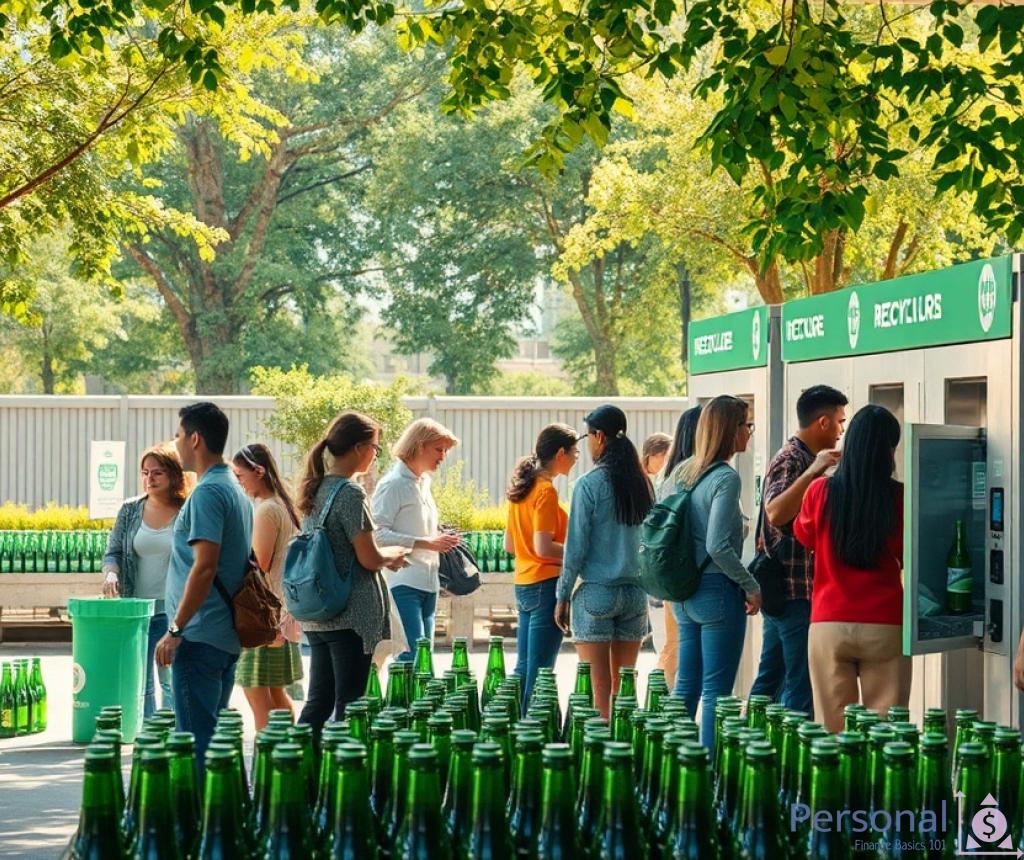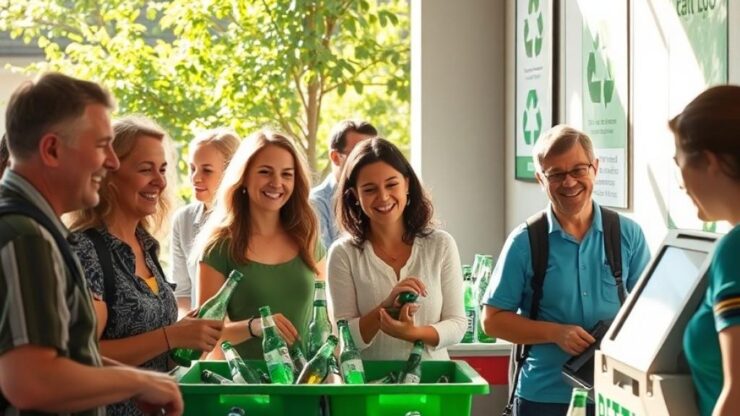Understanding Bottle Return Programs
Bottle return programs are innovative recycling initiatives designed to encourage consumers to return used beverage containers in exchange for a monetary reward. These programs not only promote environmental sustainability but also provide an opportunity for individuals to earn some extra cash. By understanding the mechanics of these programs, you can maximize your recycling efforts and contribute positively to the environment.
Engaging in bottle return programs offers numerous benefits, both for individuals and for the community at large. Participants not only gain financial incentives but also play a crucial role in reducing waste and conserving resources. Here are some compelling reasons to consider joining a bottle return program:
- Financial Gain: Earn cash back for every bottle returned, turning waste into profit.
- Environmental Impact: Reduce landfill waste and lower carbon footprints by recycling.
- Community Engagement: Participate in local initiatives that promote sustainability and community well-being.
Understanding the operational aspects of bottle return programs is essential for maximizing your participation. Typically, these programs are governed by state laws and vary in terms of deposit amounts and accepted containers. Below is a table summarizing key features of bottle return programs across different states:
| State | Deposit Amount | Container Types |
|---|---|---|
| California | $0.10 | Plastic, Glass, Aluminum |
| Michigan | $0.10 | Plastic, Glass, Aluminum |
| New York | $0.05 | Plastic, Glass, Aluminum |
To participate effectively, consumers should familiarize themselves with the specific details of their state’s program, including which containers are eligible and the locations of return facilities.
Financial Benefits of Recycling Bottles
Participating in bottle return programs not only benefits the environment but also provides significant financial incentives for everyday consumers. The act of recycling bottles may seem like a small contribution, but the cumulative effect can lead to substantial monetary rewards. Understanding the financial landscape associated with these programs can empower individuals to make informed decisions about their recycling habits.
Every bottle returned to a recycling facility is an opportunity to turn waste into cash. Many individuals may not realize that the small deposits collected at the time of purchase can add up quickly when accumulated over time. For instance, a family that regularly consumes beverages in recyclable containers can easily generate a modest income stream by diligently returning their bottles. This process encourages responsible consumption while simultaneously offering a financial incentive that offsets the cost of these beverages.
The financial benefits of bottle return programs extend beyond individual gains; they also foster a sense of community and support local economies. As more people engage in recycling, local businesses that operate return facilities often experience increased foot traffic, which can lead to enhanced sales and job creation. Furthermore, the funds generated through these programs can be reinvested into community initiatives aimed at sustainability, creating a positive feedback loop that benefits everyone involved. By participating in bottle return programs, individuals contribute not only to their personal finances but also to the economic vitality of their communities.
Environmental Impact of Bottle Returns

Participating in bottle return programs not only provides financial incentives for individuals but also plays a pivotal role in fostering a healthier planet. By understanding the environmental ramifications of returning bottles, consumers can appreciate the broader impact of their actions. This section delves into how these programs contribute to waste reduction, resource conservation, and the promotion of sustainable practices.
Every bottle returned signifies a step towards minimizing waste in landfills. The sheer volume of beverage containers discarded daily is staggering, contributing significantly to environmental degradation. Engaging in bottle return programs directly addresses this issue by ensuring that these containers are processed and recycled rather than left to clutter our landfills. When individuals collectively return their bottles, the cumulative effect results in a substantial decrease in waste. For instance, according to environmental studies, recycling one ton of glass can save over 1,000 kilograms of natural resources. This not only preserves the environment but also reduces the need for new materials.
In addition to reducing waste, bottle return programs facilitate the conservation of valuable natural resources. Recycling processes require significantly less energy and water compared to producing new products from raw materials. For example, recycled aluminum uses 95% less energy than new aluminum production. When consumers return their bottles, they contribute to a cycle of reusing materials, which in turn lessens the strain on our planet’s resources. This closed-loop system not only benefits the environment but also enhances the economic viability of recycling industries.
Furthermore, by participating in these programs, individuals become part of a larger movement that promotes responsible consumption and environmental stewardship. The awareness generated through bottle returns can inspire others to adopt similar sustainable practices, fostering a community dedicated to preserving the environment.
How to Maximize Your Returns
Participating in bottle return programs is not only a sustainable choice but also a smart financial strategy. To truly maximize your returns from these initiatives, it’s essential to adopt a proactive approach that encompasses strategic planning and informed decision-making. By understanding the nuances of bottle return mechanisms and leveraging best practices, consumers can significantly increase their cash rewards while contributing to environmental conservation.
One of the most effective strategies for maximizing returns is to familiarize yourself with the specific rules and regulations governing bottle returns in your state. Some programs may have distinct deposit values and container eligibility that can vary even within regions. Knowing exactly which bottles and cans are accepted will prevent wasted trips and ensure you receive the maximum financial benefit from your recycling efforts. Additionally, consider timing your returns strategically; many facilities offer bonus incentives or promotions that can enhance your overall earnings.
Another crucial aspect is to organize your recycling efforts systematically. Creating a designated space at home for storing recyclable bottles and cans can streamline the process. By collecting and sorting your containers regularly, you not only keep your living space organized but also prevent contamination that can jeopardize your returns. Remember that clean and undamaged containers are more likely to be accepted, so take a moment to rinse out any residue before storage.
Engaging with your community can also amplify your returns. Joining local recycling groups or initiatives can provide insights into best practices and potential local events that promote bottle returns. Sharing your experiences and tips can foster a community spirit, where collective efforts can lead to greater awareness and participation in recycling programs. Furthermore, some communities host competitions or challenges that reward individuals or groups for returning the most bottles, adding an element of fun while contributing to environmental sustainability.
Challenges and Solutions in Bottle Recycling
While bottle return programs offer a seamless way for individuals to turn waste into extra cash, they are not without their challenges. Understanding these obstacles is crucial to maximizing the benefits of recycling initiatives. From logistical issues to consumer awareness, each challenge presents an opportunity for innovative solutions that can enhance participation and effectiveness.
One of the most significant challenges faced by consumers engaging in bottle return programs is the logistical complexity of returning containers. Many individuals find it inconvenient to locate return facilities, especially in rural areas where access may be limited. Additionally, the operating hours of these facilities often do not align with the busy schedules of many consumers. This disparity can lead to frustration and decreased participation in recycling efforts.
To address these logistical hurdles, communities are encouraged to enhance the accessibility of return facilities. Implementing more drop-off locations, extending hours of operation, and even incorporating mobile return units can significantly improve participation rates. Furthermore, local governments can collaborate with businesses to create a network of accessible return points, ensuring that consumers can easily find convenient drop-off locations.
Another pressing challenge lies in consumer awareness regarding the benefits and processes involved in bottle return programs. Many individuals may not fully understand the environmental impact of their recycling efforts or the financial incentives available. This lack of awareness can result in low participation rates and missed opportunities for communities to capitalize on the positive aspects of recycling.
To combat this issue, educational campaigns play a vital role. Public service announcements, community workshops, and school programs can help disseminate information about the importance of recycling and the specifics of local bottle return programs. By fostering a culture of awareness and understanding, communities can inspire more individuals to engage in these initiatives, ultimately leading to higher rates of bottle returns and a greater positive impact on the environment.
Disclaimer
This article has been created or edited with the support of artificial intelligence and is for informational purposes only. The information provided should not be considered investment advice. Please seek the support of a professional advisor before making any investment decisions.






